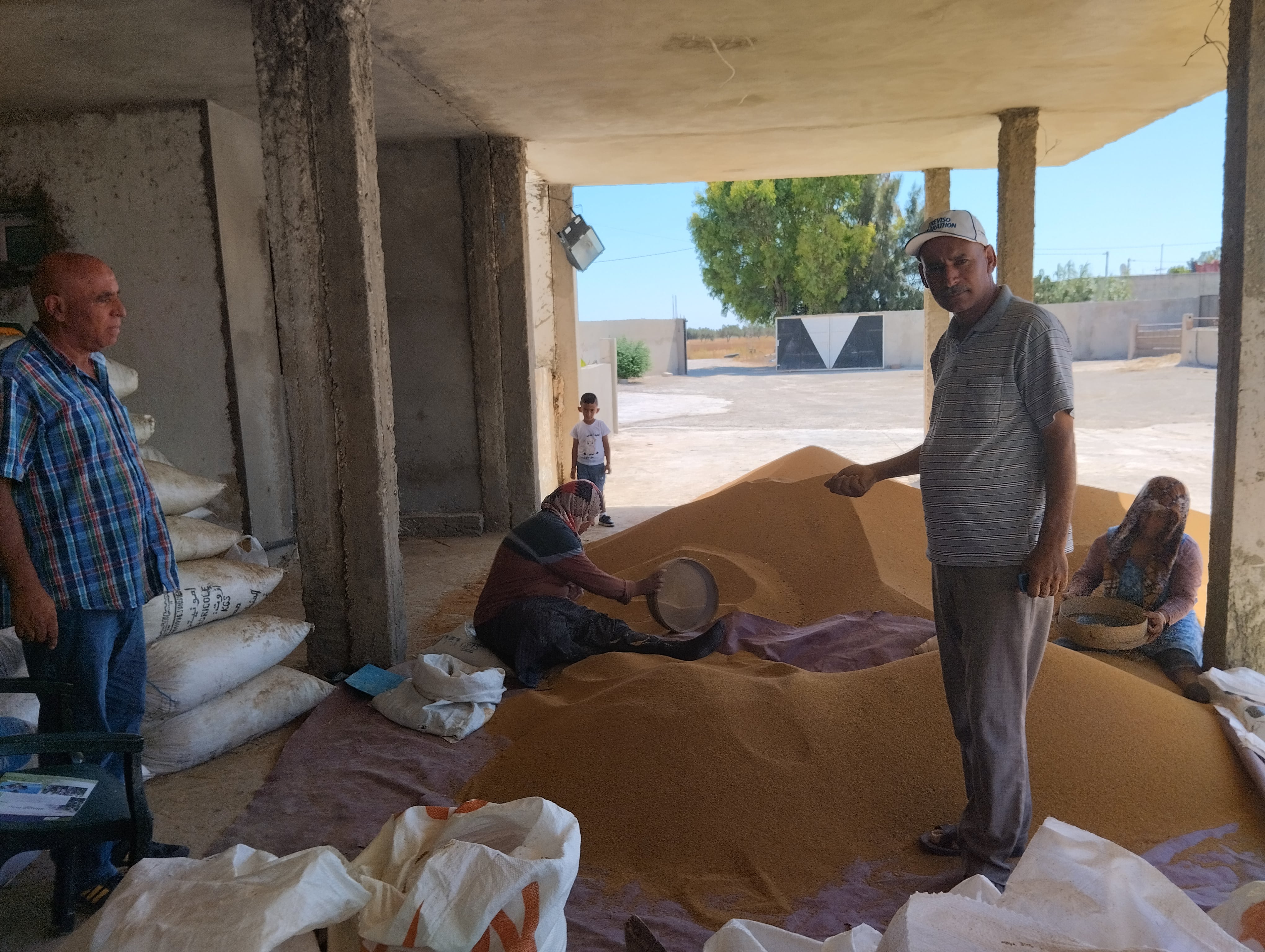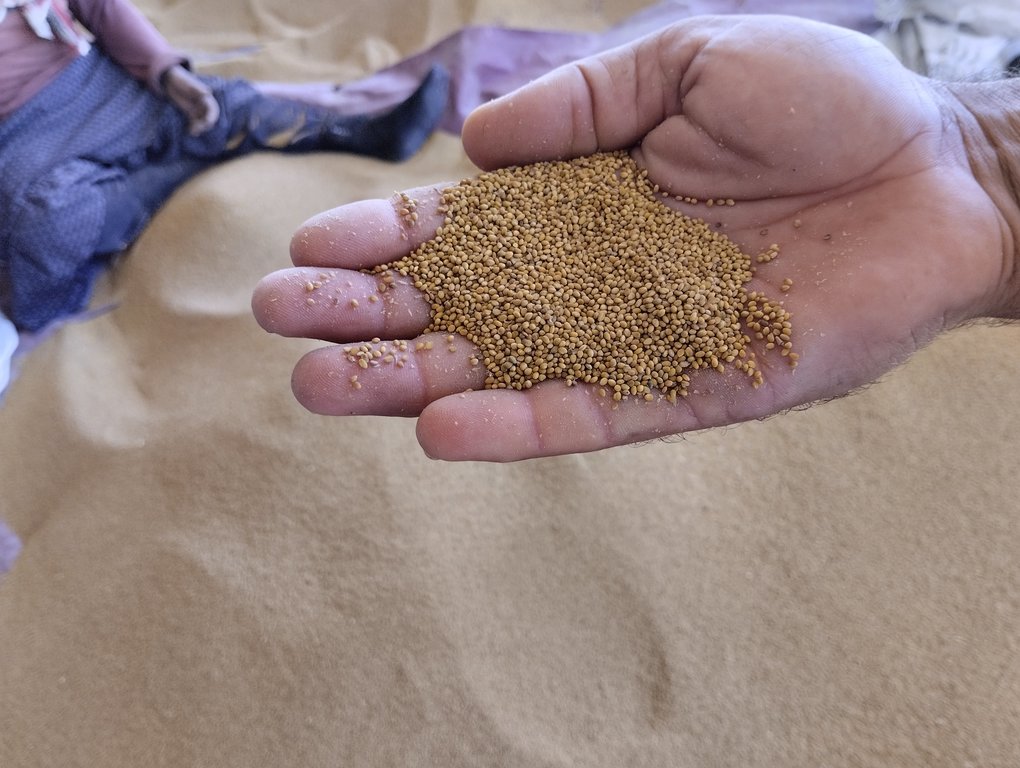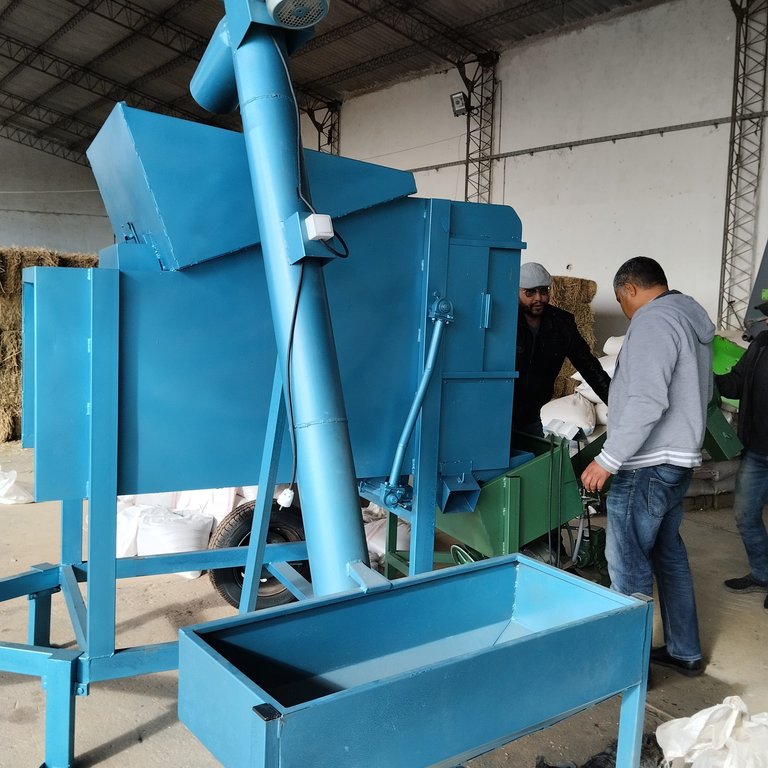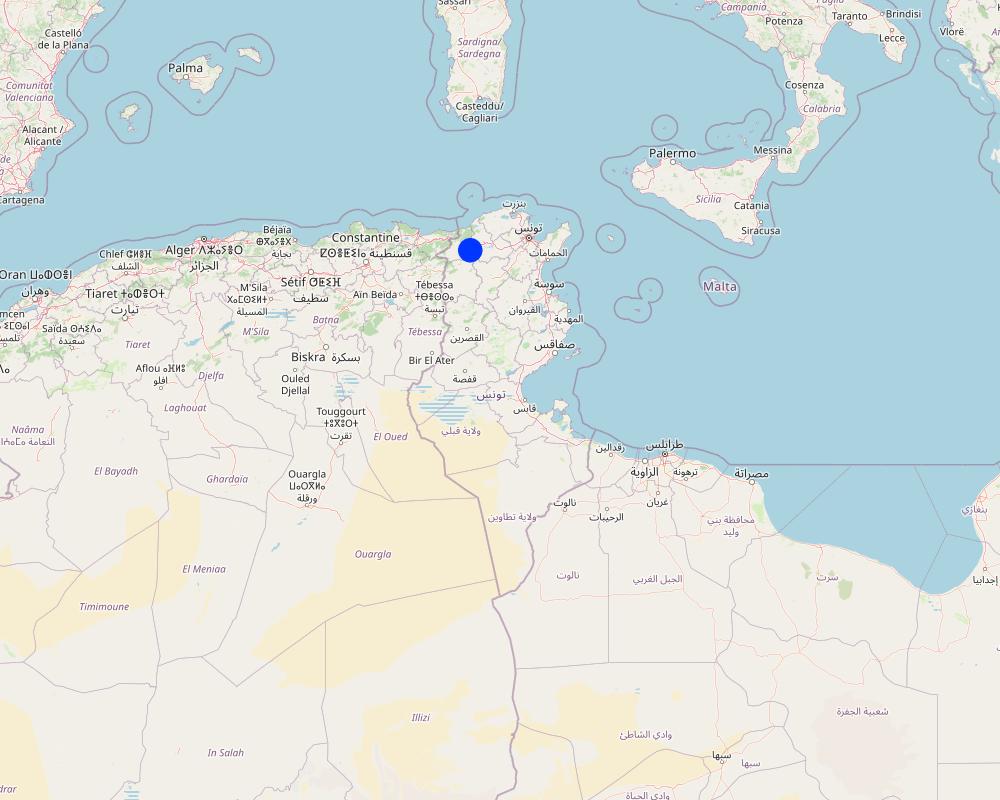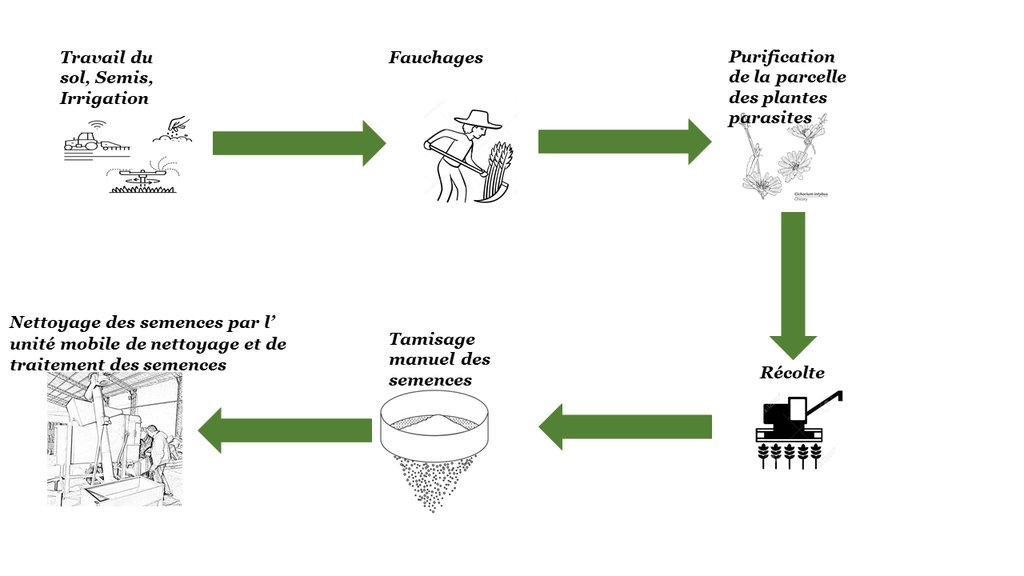Seed Cleaning and Treatment [Tunisia]
- Creation:
- Update:
- Compiler: Wafa Saidi
- Editors: Siagbé Golli, Faouzi Harrouchi, faouzi BATTI, Fatma Maaloul, Tabitha Nekesa, Ahmadou Gaye
- Reviewers: William Critchley, Rima Mekdaschi Studer
technologies_6668 - Tunisia
View sections
Expand all Collapse all1. General information
1.2 Contact details of resource persons and institutions involved in the assessment and documentation of the Technology
Key resource person(s)
SLM specialist:
Mediouni Slim
Office de l'Elevage et des Pâturage (Livestock and Pasture Office)
Tunisia
SLM specialist:
Zaiem Anis
Office de l'Elevage et des Pâturage (Livestock and Pasture Office)
Tunisia
Name of project which facilitated the documentation/ evaluation of the Technology (if relevant)
Soil protection and rehabilitation for food security (ProSo(i)l)Name of the institution(s) which facilitated the documentation/ evaluation of the Technology (if relevant)
Office de l'élevage et des paturages (OEP) - TunisiaName of the institution(s) which facilitated the documentation/ evaluation of the Technology (if relevant)
Direction Générale de l’Amenagement et de Conservation des Terres Agricoles (DG/ACTA) - TunisiaName of the institution(s) which facilitated the documentation/ evaluation of the Technology (if relevant)
GIZ Tunisia (GIZ Tunisia) - Tunisia1.3 Conditions regarding the use of data documented through WOCAT
The compiler and key resource person(s) accept the conditions regarding the use of data documented through WOCAT:
Yes
1.4 Declaration on sustainability of the described Technology
Is the Technology described here problematic with regard to land degradation, so that it cannot be declared a sustainable land management technology?
No
1.5 Reference to Questionnaire(s) on SLM Approaches (documented using WOCAT)
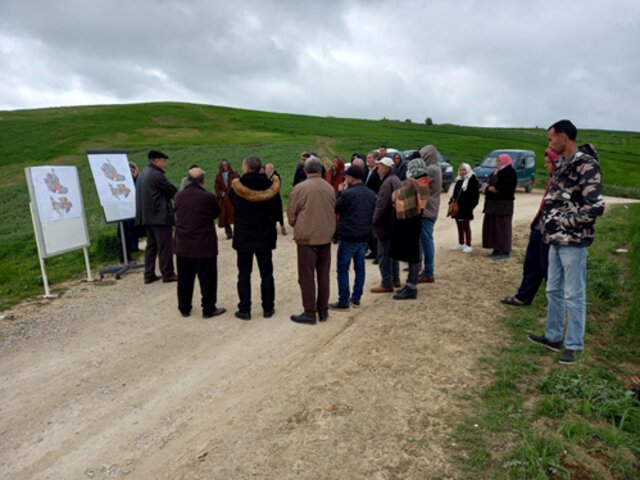
Integrated Territorial Planning and Development Project (PADIT) [Tunisia]
The PADIT approach comprises a cross-cutting participatory methodology to rural development, rallying various stakeholders around a project, within a location, to identify the main economic areas of the rural community concerned, and draw up a prioritized list of actions to strengthen and support development efforts in their location.
- Compiler: Wafa Saidi
2. Description of the SLM Technology
2.1 Short description of the Technology
Definition of the Technology:
In Tunisia, ensuring a consistent supply of quality forage and pasture seeds to farmers is a critical hurdle in advancing the livestock industry, with many farmers turning to self-produced seeds to fulfil their requirements.
2.2 Detailed description of the Technology
Description:
Farmers in Tunisia strive to enhance the quality of self-produced forage and pasture seeds, aiming to adhere to technical standards for purity and germination, often undertaking manual cleaning efforts. The initial phase, known as “purification”, occurs in the fields before the harvest. This phase focuses on weeding out unwanted plants, such as Cichorium intybus in bersim (Trifolium sp.). Post-harvest, each farmer engages in the process of cleaning the seeds to eliminate impurities using the means available to them (e.g. manually with basic implements).
Typically, additional seed cleaning, known as winnowing, is carried at the El Grine forage and pasture seed production center of the Livestock and Pasture Office (OEP) to meet quality standards.
In collaboration with national partners, the ProSol Tunisia project, spearheaded by OEP, has introduced an innovative, locally produced, "mobile seed cleaning and treatment unit". This unit, designed by a local machinery manufacturer, consists of various sieves tailored to different forage seed species (barley, vetches, faba beans, bersim, alfalfa, fenugreek, oats, forage peas, etc.).
A bucket chain feeds raw seeds directly into the machine's intake funnel at a height of 2 m. The unit operates on 220 V, ensuring ease of use for beneficiaries on their farms.
Under the ProSol/OEP partnership, two mobile seed conditioning units have been acquired. The first is allocated to the El Grine center in Kairouan, serving alfalfa seed multipliers either on their farms or at the center. The second is delivered to the OEP Fritissa farm, benefiting sulla, bersim, and other seed multipliers.
To boost the production of forage legumes, cooperatives in different regions have purchased these units, making them available to their members and developing a business model around mechanization. Through these mobile seed cleaning and treatment units, seed quality is enhanced, leading to increased revenue for farmers. Additionally, a business plan has been developed to create job opportunities and boost income for professional agricultural organizations (OPAs), mutual agricultural services societies (SMSAs), and others. This has encouraged cooperatives to acquire additional units, providing farmers with valuable services and contributing to economic growth.
2.3 Photos of the Technology
2.5 Country/ region/ locations where the Technology has been applied and which are covered by this assessment
Country:
Tunisia
Region/ State/ Province:
Jendouba
Further specification of location:
El Brahmi, Bou Salem
Specify the spread of the Technology:
- applied at specific points/ concentrated on a small area
Is/are the technology site(s) located in a permanently protected area?
No
Map
×2.6 Date of implementation
Indicate year of implementation:
2018
2.7 Introduction of the Technology
Specify how the Technology was introduced:
- during experiments/ research
3. Classification of the SLM Technology
3.1 Main purpose(s) of the Technology
- improve production
- create beneficial economic impact
3.2 Current land use type(s) where the Technology is applied
Land use mixed within the same land unit:
No

Cropland
- Annual cropping
Annual cropping - Specify crops:
- fodder crops - other
Is intercropping practiced?
No
Is crop rotation practiced?
Yes

Waterways, waterbodies, wetlands
- Ponds, dams
3.3 Has land use changed due to the implementation of the Technology?
Has land use changed due to the implementation of the Technology?
- No (Continue with question 3.4)
3.4 Water supply
Water supply for the land on which the Technology is applied:
- full irrigation
3.5 SLM group to which the Technology belongs
- improved plant varieties/ animal breeds
- post-harvest measures
3.6 SLM measures comprising the Technology

agronomic measures
- A5: Seed management, improved varieties

vegetative measures
- V4: Replacement or removal of alien/ invasive species

management measures
- M2: Change of management/ intensity level
- M5: Control/ change of species composition
3.7 Main types of land degradation addressed by the Technology

biological degradation
- Bc: reduction of vegetation cover
- Bs: quality and species composition/ diversity decline
3.8 Prevention, reduction, or restoration of land degradation
Specify the goal of the Technology with regard to land degradation:
- not applicable
Comments:
This technology is designed to provide an adequate and reliable supply of superior-grade forage seed.
4. Technical specifications, implementation activities, inputs, and costs
4.1 Technical drawing of the Technology
4.2 General information regarding the calculation of inputs and costs
Specify how costs and inputs were calculated:
- per Technology area
Indicate size and area unit:
10 ha
other/ national currency (specify):
Tunisian dinar
If relevant, indicate exchange rate from USD to local currency (e.g. 1 USD = 79.9 Brazilian Real): 1 USD =:
3.1
Indicate average wage cost of hired labour per day:
20
4.3 Establishment activities
| Activity | Timing (season) | |
|---|---|---|
| 1. | Ploughing | August |
| 2. | Seeding | September |
| 3. | Irrigation | |
| 4. | Mowing | December to mid-May |
| 5. | Purification of the plot of parasitic plants (Cichorium intybus) | |
| 6. | Harvesting |
4.4 Costs and inputs needed for establishment
| Specify input | Unit | Quantity | Costs per Unit | Total costs per input | % of costs borne by land users | |
|---|---|---|---|---|---|---|
| Labour | Workers | Man-day | 6.0 | 20.0 | 120.0 | 100.0 |
| Equipment | Labour | Hour | 4.0 | 40.0 | 160.0 | 100.0 |
| Equipment | Seeding machine | Hour | 1.0 | 70.0 | 70.0 | 100.0 |
| Equipment | Combine harvester | Hour | 1.5 | 100.0 | 150.0 | 100.0 |
| Plant material | Seed | kg | 20.0 | 5.5 | 110.0 | 100.0 |
| Fertilizers and biocides | Manure | Hour | 0.5 | 70.0 | 35.0 | 100.0 |
| Fertilizers and biocides | DAP | kg | 100.0 | 0.8 | 80.0 | 100.0 |
| Other | Transportation | 1.0 | 40.0 | 40.0 | 100.0 | |
| Other | Irrigation | m3 | 4000.0 | 0.12 | 480.0 | 100.0 |
| Total costs for establishment of the Technology | 1245.0 | |||||
| Total costs for establishment of the Technology in USD | 401.61 | |||||
4.5 Maintenance/ recurrent activities
| Activity | Timing/ frequency | |
|---|---|---|
| 1. | Manual seed sieving | |
| 2. | Cleaning of the seeds sieved using the mobile seed cleaning and processing unit |
4.6 Costs and inputs needed for maintenance/ recurrent activities (per year)
| Specify input | Unit | Quantity | Costs per Unit | Total costs per input | % of costs borne by land users | |
|---|---|---|---|---|---|---|
| Labour | Workers | Man-day | 4.0 | 20.0 | 80.0 | 100.0 |
| Other | Transportation | 2.0 | 40.0 | 80.0 | ||
| Total costs for maintenance of the Technology | 160.0 | |||||
| Total costs for maintenance of the Technology in USD | 51.61 | |||||
4.7 Most important factors affecting the costs
Describe the most determinate factors affecting the costs:
Availability of workers
5. Natural and human environment
5.1 Climate
Annual rainfall
- < 250 mm
- 251-500 mm
- 501-750 mm
- 751-1,000 mm
- 1,001-1,500 mm
- 1,501-2,000 mm
- 2,001-3,000 mm
- 3,001-4,000 mm
- > 4,000 mm
Specify average annual rainfall (if known), in mm:
820.00
Specifications/ comments on rainfall:
The region is characterized by abundant rainfall, with considerable inter-annual and inter-seasonal variations. The winter months experience the highest precipitation levels, while the summer and autumn periods are the driest.
Indicate the name of the reference meteorological station considered:
Zouem SM
Agro-climatic zone
- sub-humid
The average annual temperature ranges between 15° and 20°C.
5.2 Topography
Slopes on average:
- flat (0-2%)
- gentle (3-5%)
- moderate (6-10%)
- rolling (11-15%)
- hilly (16-30%)
- steep (31-60%)
- very steep (>60%)
Landforms:
- plateau/plains
- ridges
- mountain slopes
- hill slopes
- footslopes
- valley floors
Altitudinal zone:
- 0-100 m a.s.l.
- 101-500 m a.s.l.
- 501-1,000 m a.s.l.
- 1,001-1,500 m a.s.l.
- 1,501-2,000 m a.s.l.
- 2,001-2,500 m a.s.l.
- 2,501-3,000 m a.s.l.
- 3,001-4,000 m a.s.l.
- > 4,000 m a.s.l.
Indicate if the Technology is specifically applied in:
- not relevant
5.3 Soils
Soil depth on average:
- very shallow (0-20 cm)
- shallow (21-50 cm)
- moderately deep (51-80 cm)
- deep (81-120 cm)
- very deep (> 120 cm)
Soil texture (topsoil):
- medium (loamy, silty)
Soil texture (> 20 cm below surface):
- medium (loamy, silty)
Topsoil organic matter:
- high (>3%)
5.4 Water availability and quality
Ground water table:
> 50 m
Availability of surface water:
good
Water quality (untreated):
for agricultural use only (irrigation)
Water quality refers to:
ground water
Is water salinity a problem?
No
Is flooding of the area occurring?
No
5.5 Biodiversity
Species diversity:
- medium
Habitat diversity:
- medium
5.6 Characteristics of land users applying the Technology
Sedentary or nomadic:
- Sedentary
Market orientation of production system:
- commercial/ market
Off-farm income:
- less than 10% of all income
Relative level of wealth:
- rich
Individuals or groups:
- individual/ household
Level of mechanization:
- manual work
- mechanized/ motorized
Gender:
- women
- men
Age of land users:
- middle-aged
5.7 Average area of land used by land users applying the Technology
- < 0.5 ha
- 0.5-1 ha
- 1-2 ha
- 2-5 ha
- 5-15 ha
- 15-50 ha
- 50-100 ha
- 100-500 ha
- 500-1,000 ha
- 1,000-10,000 ha
- > 10,000 ha
Is this considered small-, medium- or large-scale (referring to local context)?
- medium-scale
5.8 Land ownership, land use rights, and water use rights
Land ownership:
- individual, not titled
Land use rights:
- individual
Water use rights:
- communal (organized)
Are land use rights based on a traditional legal system?
Yes
Specify:
Heritage
5.9 Access to services and infrastructure
health:
- poor
- moderate
- good
education:
- poor
- moderate
- good
technical assistance:
- poor
- moderate
- good
employment (e.g. off-farm):
- poor
- moderate
- good
markets:
- poor
- moderate
- good
energy:
- poor
- moderate
- good
roads and transport:
- poor
- moderate
- good
drinking water and sanitation:
- poor
- moderate
- good
financial services:
- poor
- moderate
- good
6. Impacts and concluding statements
6.1 On-site impacts the Technology has shown
Socio-economic impacts
Production
crop production
Comments/ specify:
Cleaned seeds improve crop productivity by 150%.
crop quality
Comments/ specify:
Seed cleaning plays a crucial role in maintaining the genetic purity of crop varieties.
fodder production
Comments/ specify:
Green mowing repeated twice
fodder quality
risk of production failure
Comments/ specify:
High-quality seeds are used, reducing the risk of production failure
product diversity
Comments/ specify:
Green products, seeds
Income and costs
farm income
diversity of income sources
Comments/ specify:
Sale of green products, seeds
workload
Comments/ specify:
By using high-quality cleaned seed, farmers can reduce the need for additional inputs such as fertilizers, pesticides or herbicides.
Socio-cultural impacts
food security/ self-sufficiency
Comments/ specify:
Self-procurement of seeds
Ecological impacts
Biodiversity: vegetation, animals
invasive alien species
Comments/ specify:
Purification of the plot from pest plants
Specify assessment of on-site impacts (measurements):
Impact assessment involves measurements on a pilot plot.
6.2 Off-site impacts the Technology has shown
Preservation of genetic purity
Comments/ specify:
Seed cleaning plays a crucial role in maintaining the genetic purity of crop varieties.
Specify assessment of off-site impacts (measurements):
This technology has no off-site impact.
6.3 Exposure and sensitivity of the Technology to gradual climate change and climate-related extremes/ disasters (as perceived by land users)
Gradual climate change
Gradual climate change
| Season | increase or decrease | How does the Technology cope with it? | |
|---|---|---|---|
| annual rainfall | decrease | well | |
| seasonal rainfall | wet/ rainy season | decrease | well |
6.4 Cost-benefit analysis
How do the benefits compare with the establishment costs (from land users’ perspective)?
Short-term returns:
very positive
Long-term returns:
very positive
How do the benefits compare with the maintenance/ recurrent costs (from land users' perspective)?
Short-term returns:
very positive
Long-term returns:
very positive
6.5 Adoption of the Technology
- 1-10%
Of all those who have adopted the Technology, how many did so spontaneously, i.e. without receiving any material incentives/ payments?
- 11-50%
6.6 Adaptation
Has the Technology been modified recently to adapt to changing conditions?
No
6.7 Strengths/ advantages/ opportunities of the Technology
| Strengths/ advantages/ opportunities in the land user’s view |
|---|
| Increased yield: Using high-quality seeds leads to improved yields, which in turn means higher profits and enhanced food security. |
| Preserving local crop varieties |
| Profitability: Minimize the cost of purchasing seeds while providing another source of income through the sale of the seeds produced. |
| Strengths/ advantages/ opportunities in the compiler’s or other key resource person’s view |
|---|
| Resilience to climate change: The seed multiplication and cleaning technique provides access to climate-resistant crop varieties, helping farmers to adapt to climate change and maintain productivity and livelihoods under changing climatic conditions. |
| Improved seed quality and diversity |
| Stimulation of local economies and improved livelihoods through the creation of employment opportunities |
6.8 Weaknesses/ disadvantages/ risks of the Technology and ways of overcoming them
| Weaknesses/ disadvantages/ risks in the land user’s view | How can they be overcome? |
|---|---|
| The relatively high upfront investment needed to set up a seed a seed multiplication and cleaning system may pose a challenge for certain farmers, especially smallholders. | Incentivizing farmers through subsidies |
| Weaknesses/ disadvantages/ risks in the compiler’s or other key resource person’s view | How can they be overcome? |
|---|---|
| Climate change can have an impact on crop productivity and affect seed multiplication and cleaning activities. | Promote climate-friendly farming practices |
7. References and links
7.1 Methods/ sources of information
- field visits, field surveys
A visit to a seed multiplier
- interviews with land users
A visit to a seed multiplier
- interviews with SLM specialists/ experts
Interviews with two experts from the Livestock and Pasture Office
- compilation from reports and other existing documentation
When were the data compiled (in the field)?
02/02/2023
7.2 References to available publications
Title, author, year, ISBN:
Locally manufactured seedcleaning and treatment unit: Improve seed quality, Udo Rudiger and Anis Zaiem
Available from where? Costs?
International Center for Agricultural Research in the Dry Areas (ICARDA)
Title, author, year, ISBN:
Cahier de charge relatif à la production et à la multiplication des semences et plants,
Available from where? Costs?
Ministry of Agriculture
Title, author, year, ISBN:
Mobile seed cleaning and treatment unit designed and developed with support from ICARDA, 2019, Zied Idoudi, Udo Rudiger
Available from where? Costs?
International Center for Agricultural Research in the Dry Areas (ICARDA)
7.3 Links to relevant online information
Title/ description:
Outils de formation pour la production de semences de qualité: Module 1: Le développement d’entreprises semencières à petite échelle, 2019, FAO ET AFRICASEEDS
URL:
https://duddal.org/files/original/feefacb4735d646101fb82e4a5140801597e2b3c.pdf
Title/ description:
Rudiger, U. 2020. Mobile seed cleaning and treatment units as business opportunities for farmer cooperatives in Tunisia. Poster prepared for the Virtual Livestock CRP Planning Meeting, 8-17 June 2020. Tunisia: ICARDA.
URL:
https://cgspace.cgiar.org/bitstream/handle/10568/109777/udo.pdf?sequence=1&isAllowed=y
Title/ description:
Report on business development of cooperatives using mobile seed treatment units for their members in Tunisia, 2018, Udo Rudiger and Anis Zaiem
URL:
https://docplayer.net/210998499-Report-on-business-development-of-cooperatives-using-mobile-seed-treatment-units-for-their-members-in-tunisia.html
Links and modules
Expand all Collapse allLinks

Integrated Territorial Planning and Development Project (PADIT) [Tunisia]
The PADIT approach comprises a cross-cutting participatory methodology to rural development, rallying various stakeholders around a project, within a location, to identify the main economic areas of the rural community concerned, and draw up a prioritized list of actions to strengthen and support development efforts in their location.
- Compiler: Wafa Saidi
Modules
No modules


